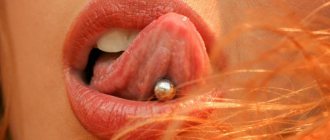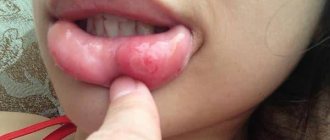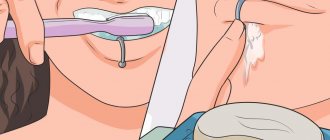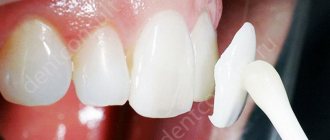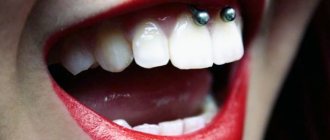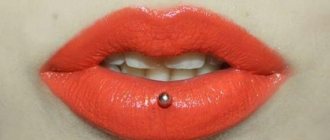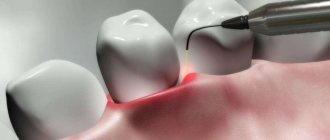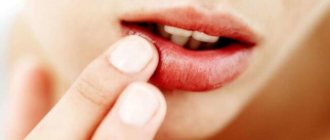Youthful maximalism knows no boundaries. To stand out from the crowd, teenagers are ready for any experiments. Bright hair, provocative makeup, tattoos and even piercings. The latter gained popularity at the end of the last century and to this day is one of the most frequently used methods of self-expression. Young people pierce their eyebrows, lips, nose. However, the most desirable thing is a piercing on a girl's tongue. Owners of such jewelry believe that it is incredibly sexy and try to demonstrate it at every opportunity.
Tongue piercing: to do or not?
Before getting a tongue piercing, you may want to consider broken teeth, drooling, gum and nerve damage, loss of taste, tooth loss, or infections.
All of these problems can result from this procedure. People who have had piercings often develop cracks in their tooth enamel. This occurs due to constant mechanical trauma to the teeth during eating, sleeping, or talking.
The crack may be limited to the enamel of the tooth and require a filling, or it may extend deep into the tooth, in which case endodontic treatment (root canal treatment) or tooth extraction will be required.
We often have to deal with infections. It is known that oral infections can spread to other organs and systems of the body. The surface of the tongue is covered with bacterial plaque. When the tongue is pierced, bacteria enter the bloodstream. Once this happens, the bacteria can travel through the bloodstream, causing a number of serious problems, one of them being endocarditis (inflammation of the heart or its valves).
Tongue piercing is a potential risk factor for the transmission of herpes simplex virus and hepatitis B and C.
When carrying out this procedure (tongue puncture), complications cannot be excluded: nerve damage, prolonged bleeding, which results in numbness of the tongue or loss of sensitivity at the puncture site, or limitation of movement. If blood vessels have been damaged, prolonged bleeding may occur. Swelling of the tongue associated with a piercing can be severe enough to cause blockage of the upper respiratory tract and make breathing significantly more difficult.
Inflammation of the gums. People with barbell piercings are at greater risk of gum disease than people without oral piercings. Jewelry can come into contact with gum tissue, causing damage or recession, which can lead to loose teeth or tooth loss.
Difficulties appear in everyday speech functions.
A tongue piercing can cause difficulty chewing and swallowing food, and may also interfere with clear speech. This happens because jewelry provokes increased salivation.
Temporary or constant drooling is another consequence of excessive saliva production. A change in taste may also occur.
Allergic reactions to metal. A hypersensitivity reaction to metal in jewelry, often called allergic contact dermatitis, can occur in some people. Inhaling jewelry. Jewelry that is not securely secured in the mouth can pose a choking hazard and, if swallowed, may cause injury to the esophagus or lungs.
Tongue piercing can be one of the causes of tongue cancer, as this organ is traumatized.
If you do decide to pierce your tongue, take care of it very carefully. After the piercing, the tongue heals within four to six weeks. In order to avoid complications, the jewelry can be removed for a short time so that the puncture site does not close. Always remove jewelry when eating or sleeping.
To avoid serious infections such as HIV or hepatitis, make sure the piercer uses sterile instruments. Find out all the questions related to aftercare, hygiene and anything else that worries you.
Prepared by: dentist Arefieva Yu.V.
Where can men wear jewelry?
Guys get pierced in almost every part of their face and, like girls, except for the navel. Plane piercing is less popular among guys; it is mainly used by girls. While it's not illegal or publicly frowned upon, there are far fewer guys getting small metal implants into their collarbones, ankles, wrists or pelvic bones.
Eyebrow piercing
Piercing the outer part of the eyebrow is a universal method of decorative perforation of the skin, but statistically there are much fewer girls who decide to do it. This may be due to a certain amount of pain in the procedure. In the early 2000s, it was fashionable among young people to wear an earring or a barbell in their eyebrows. The first Russian star to make it was Sergei Amoralov, a member of the boy band “Dirty Rotten Scoundrels.” Among female stars, the most famous example of wearing an eyebrow accessory is Fergie.
Nose piercing
Both men and women get their noses pierced. But young men prefer to decorate either the wing or the nasal septum, into which a simple ring or barbell is inserted. Nostrils with rhinestones and other shiny objects are a woman's prerogative. In informal youth movements, guys decorate soft tissues in the bridge of the nose. Another nuance that distinguishes the male type of nose piercing from the female one is more extreme forms. For example, some young people insert tunnels into the wing of the nose and, over time, widen the opening, causing the sinuses to become visible. These are isolated cases of guys who spoil their appearance in this way. Girls do not dare to do this, because... value their appearance.
Tongue piercing
This method of body modification also does not differ by gender. Both young men and girls who are looking for new bright sensations in intimate relationships get their tongues pierced. According to those who have had their tongue pierced, a foreign object in the mouth allows them to receive and deliver more pleasure from kissing and, especially, from oral sex.
Lip piercing
Very often you can find guys around 20-22 years old who prick their lower lip and decorate it with a round earring. Most of them are representatives of the so-called. “bohemia”, show business and various informal movements. It is not customary to pierce the upper lip of older men after 30; only teenagers and young men who are experimenting with their appearance and looking for themselves agree to this type of modification. In general, earrings or barbells in the lip area are perceived by society as a more feminine way of decorating the face.
Nipple piercing
Both men and women insert earrings into their chests, but the percentage of the latter is much higher. Guys who decide to pierce their nipples usually do it for some kind of masochistic pleasure or to attract attention. In the latter case, it is assumed that the rings or barbells in the nipples will be visible to others. Therefore, guys and men who pierce the nipple area are usually engaged in specific activities: modeling, striptease, filming, etc.
Genital piercing
Males often get their genitals pierced. Mostly the foreskin and glans penis are pierced. The most popular type of penis decoration is the so-called. Prince Albert - insertion of a ring at the base of the penis in the frenulum area, as well as through puncture of the glans vertically, horizontally or diagonally.
By analogy with men, there is also female genital piercing, when rings are inserted into the hood or head of the clitoris, the labia majora and minora, and the fold in the pubic area.
Side effects of piercing
The side effects that can occur after getting a piercing are numerous. Incorrect installation of piercings in both the upper and lower lips can lead to irreversible consequences, such as damage to the facial nerve. Also, the piercing procedure itself guarantees inevitable swelling and bleeding.
Regular contact of metal parts with tooth enamel leads to its damage, this can be either minor microcracks or severe chips. In fact, the teeth of a person who has had an oral piercing are constantly injured 24 hours a day. When you talk, chew, or simply move your tongue, the hard metal earring continually damages your tooth enamel.
After some time, tiny cracks invisible to the human eye develop into quite serious problems. There is increased sensitivity of the teeth to irritants such as cold, heat and acids. Constant irritation of the nerve leads to caries.
Due to the occurrence of galvanic currents between the metal of the earring and other metals in the mouth, severe irritation of the pulp can occur. Plus, this is facilitated by the acidic environment in the mouth.
Piercing also entails a change in the normal function of the oral cavity. Foreign objects, particularly jewelry in the mouth, can trigger excessive saliva production, which can significantly affect the clarity of pronunciation, as well as chewing and swallowing food. This is not particularly convenient in everyday life.
Ear piercing - types and meaning
The most common type of piercing is symmetrically placed earrings in pierced female earlobes. Symbolism in such jewelry is completely absent. The situation is more complicated with male ear piercing, since one earring in the right ear for many means the owner is gay.
Reasons for pain
The following factors can cause characteristic tongue pain:
- Organ injuries.
- Inflammation.
- Allergy.
- Neurological disease.
- Pathologies of internal organs.
- Tumor formation.
- Blockage of the salivary gland.
The most common cause of pain on one side of the tongue is damage to it. As a rule, this is noted during meals. Injuries may include burns, pinching, or scratches. As a result, pain can occur on the upper part, under the tongue or in its side.
Also, a muscular organ can hurt due to a chipped layer of tooth enamel, tingling from the sharp edge of a filling, or prosthetics performed with violations. With mechanical influence, increased pain is noted. In a situation where a patient has difficulty swallowing, and there is also discomfort in the throat or palate, there is a need to visit a doctor and ask him why this is happening.
You should pay attention to the nasopharynx, since as a result of its damage, one sign may appear - swelling of the lymph nodes under the tongue. Many parents are puzzled by the question of why a child’s tongue may hurt at its base, as well as its side, accompanied by plaque and pain when swallowing
But only a qualified doctor can help resolve this issue due to the possible presence of purulent sore throat, which requires immediate administration of adequate therapy
Many parents are puzzled by the question of why a child’s tongue may hurt at its base, as well as its side, accompanied by plaque and pain when swallowing. But only a qualified doctor can help resolve this issue due to the possible presence of purulent sore throat, which requires immediate administration of adequate therapy.
An allergic reaction often occurs due to the fault of certain products, as well as medications. Moreover, signs may appear immediately after their adoption. Some fruits, berries, smoking and alcohol can serve as provocateurs. Neurological disease glossalgia, which arises under the influence of a malfunction of the endocrine system and neurotic disorders. So, a sick person may experience burning, tingling and numbness of the organ.
Diseases of internal organs of unknown etiology often cause pain. All this happens due to various changes in human health, since the tongue reacts sharply to any ailments of an infectious nature - glossitis, as well as pathologies of the gastrointestinal tract, cardiovascular system and even anemia.
Oncological lesions often create conditions for the tongue to begin to hurt on the right or left side. Because of this, the pain syndrome is localized inside the tongue. Moreover, the nature and intensity of pain directly depends on the stage of the malignant disease. In this case, the patient is referred to an oncologist.
Where can you pierce your tongue?
The earring should only be installed in a salon by a qualified technician.
It is very important that the piercer has all the necessary documents confirming the right to carry out such procedures.
Attempts to pierce the tongue at home can lead to irreversible consequences, including sepsis and tissue necrosis. Therefore, under no circumstances should you do a piercing at home, with friends. The lack of sterility and often the necessary skills on the part of the “master” is a direct path to complications after the procedure.
Note! A licensed piercer will never pierce the tongue of a minor child without parental consent. If the master is not interested in age, but immediately offers to start the procedure, this is a sign that he should not be trusted with your health.
When should you see a doctor?
You should consult a doctor if signs of infection develop
Qualified medical care should be sought if:
- there are signs of infection, such as fever, severe pain, new swelling, or enlarged lymph nodes in the neck;
- symptoms of infection do not subside several days after starting treatment;
- the site of tissue damage constantly bleeds;
- green or yellow pus is released from the site of injury;
- there is an unpleasant odor from the mouth;
- toothache or swollen gums;
- swelling develops or tissue growths form anywhere in the oral cavity.
In addition to meeting with your doctor, you can also visit a piercer and get recommendations on how to relieve pain and other symptoms.
Many piercers give their clients tips to speed up healing and ease discomfort.
However, it is important to understand that consultations with a piercer cannot replace the advice of a doctor.
When to see a piercing
Unless your piercing says otherwise, continue with daily cleaning and soaking. Continue until all symptoms disappear and the tongue piercing is completely healed.
Contact your doctor if your symptoms do not improve within two to three days or if they worsen. He can examine the piercing and make specific recommendations for cleaning and care. Beauty salon tattoo tongue piercing enlarge individual parts.
Tongue piercing
Original and provocative tongue piercing: pros and cons, how it will be
It is worth understanding what it is to decorate your own body, it is far from easy, and you will have to make this decision if you really want to have such an original accessory in your mouth as a stud bar. Moreover, few people realize that tongue piercing, the consequences of which may not be pleasant, to put it mildly, also has a secret sacred meaning. The first such punctures were invented by the ancient tribes of American Indians, who, with its help, performed special rituals to reunite their divine nature with their human nature.
Need to know
The tongue piercing operation is virtually painless and is most often performed without the use of anesthesia or any anesthetics. However, the healing process can be quite painful. For example, you will have to switch to liquid food for a while, give up a lot of things that you are used to, so you should think carefully about everything in advance before agreeing to the procedure.
However, the secret meaning of this action has been completely lost over the centuries, and modern fashionistas and fashionistas are already doing tongue piercing for completely different reasons
Each of these reasons may have their own, but the most common is, of course, giving special pleasure to the partner in terms of sex, and this is an important factor that, of course, must be taken into account
When understanding how tongue piercing is done, the pros and cons of this process should be taken into account first and foremost. First of all, so as not to get serious consequences, and they really can appear soon. It is worth understanding that the puncture procedure can only be carried out by a real professional in the salon. You should not go to his home or invite the master to your place, because it is quite difficult to provide decent conditions for this process.
How much does tongue piercing cost in the salon and at home, what does the price depend on?
Since tongue piercing is a mini-operation, it must be carried out in a medical setting. This should be a specially equipped office, decorated with tiles or plastic and good lighting. The quartzization procedure must be carried out regularly.
All piercing equipment must be for one-time use and must be printed in front of the client. Before putting on jewelry, the salon worker must sterilize it in alcohol or an ultraviolet sterilizer.
The price of a piercing in a salon depends on factors such as:
- location - getting a piercing in the center is more expensive than further from the center.
- number of services - for example, a salon may offer free physical therapy for a month until the puncture heals. Of course, the more services, the more expensive the puncture.
- fame - salons with a name include a premium for fame in the price of services.
So how much does a piercing cost? The minimum price in Moscow is 800 rubles without an earring and 1200 with an earring. Maximum - 3600 without earrings.
Tongue piercing can be done not only in the salon, but also at home . Then you can buy everything you need at the nearest pharmacy: a catheter, more than jewelry, sterile cotton wool, bandages and gloves, alcohol, hydrogen peroxide, alcohol and saline solution (or Miramistin).
It is difficult to do a puncture on your own and therefore it is better to agree with the specialist in advance. Prices for tongue piercing vary from 800 to 1500 rubles in Moscow.
Possible complications
Below we will look at the main disadvantages of tongue piercing for the oral cavity. All of the listed consequences of this procedure are not “rare exceptions”, but on the contrary, they appear in most cases.
- Infection. Believe it or not, an incredible amount of bacteria accumulates in the mouth. As a result of their vital activity, swelling and inflammation may develop at the puncture site, and an infection may develop. If not treated immediately, the infection can become life-threatening. Another, possibly unexpected complication is tongue swelling. A swollen tongue can block the airway and cause suffocation.
- Damage to teeth and gums. People who bite and play with their piercings run the risk of damaging and weakening their gums. Weakened gums eventually lead to loosening and tooth loss. In addition, this addiction sometimes leads to cracks in tooth enamel and damage to fillings, especially if a person has sensitive enamel. One study found that nearly half of people with a ball-shaped tongue jewel that had been in their mouth for more than four years had at least one chip on their tooth.
- Allergic reactions. People with particular sensitivities to metals are at risk of developing allergies as a result of piercings.
- Numbness. Sometimes people experience numbness after a tongue piercing due to nerve damage. Fortunately, this complication is temporary, but in rare cases it does not go away. Nerve damage can make it difficult to move your mouth and affect your sense of taste.
- Increased salivation. Tongue piercing leads to excessive salivation, impaired diction, difficulty chewing and swallowing food.
- Dental x-rays are difficult. Piercings can make dental examinations difficult because jewelry blocks or distorts X-rays. As a result, you have to “reshoot” several times to achieve a good image.
Caring for the puncture site: dos and don’ts after the procedure
How to care for a pierced tongue immediately after the piercing procedure during the initial healing stage:
- Accept that in the first days the wound may bleed and be bothered by excessive sensitivity. This is normal for the first period.
- To relieve swelling, drink ice water. You can keep the ice in your mouth for a while. It will become easier. To avoid frostbite in the mouth, use small pieces.
- Don't smoke, don't drink alcohol, don't drink a lot of coffee, avoid French kissing, oral sex. Avoid chewing gum. Don't play with the decoration yet.
- Eliminate spicy, salty, sour, and hot foods for a while.
- Whitish mucus may be discharged. If it's not pus, there's no need to worry.
Further care is as follows:
- Before each cleaning, wash your hands thoroughly with soap, preferably antibacterial. Apart from cleaning, do not touch the wound yet.
- In the first days, you need to rinse your mouth with an alcohol-based, fluoride-based rinse (4-5 times after meals and before bed). The duration of the procedure is 1 minute.
- Clean the wound with sea salt twice daily. Then wash it with antimicrobial soap. But don't do this procedure often.
- You need to dry the puncture correctly. Do not wipe it with a bath towel. To do this, use a disposable napkin or paper towel.
Treatment with medical and folk remedies
If the root cause when the tongue begins to hurt is identified as stomatitis, then, as a rule, the specialist prescribes a cycle of antibiotics and treatment of the oral cavity with antiseptic drugs - Miramistin or Chlorhexidine.
If the stumbling block is a disease of the endocrine system, then hormonal treatment is prescribed; as a rule, the problem is determined by diabetes. In a situation where ailments unrelated to dentistry are identified, only one or several qualified specialists can prescribe drug treatment. Traditional methods of treatment can be used if the source of pain does not have serious reasons.
Then, to stop your tongue from hurting, you can rinse with a salt or soda solution, and also hold the oil from sea buckthorn seeds for a while without swallowing.
To exclude such signs, it is important to carefully monitor the hygienic condition of the oral cavity by regularly brushing your teeth and tongue, not forgetting about timely examinations by the dentist, so that you do not end up having to treat the entire body. The main aspect in the implementation of therapy is the impact on the internal part of the body and the implementation of treatment at the local level
The main aspect in the implementation of therapy is the impact on the internal part of the body and the implementation of treatment at the local level.
Contraindications
Tongue barbell piercing (you can choose a product in any specialized store or salon) has a number of contraindications for which it is not recommended to perform a piercing.
Main contraindications:
- Exacerbation of chronic diseases. The introduction of a foreign object into the mucosa can lead to the development of complications against the background of the existing pathological process. Refers to infectious or cold diseases, in the presence of which piercing can aggravate the course of the disease.
- Diseases that affect blood clotting. Incorrectly performed piercing can lead to the development of particularly dangerous complications for the entire body.
- Pregnancy. This is explained by the fact that during pregnancy, it is especially important to avoid any risk of infectious or bacterial contamination. Neglecting a contraindication can cause irreparable harm to the fetus.
- Presence of allergic reactions. The presence of certain allergens, as well as individual intolerance to the substance in the jewelry, can contribute to the rapid development of severe symptomatic manifestations, including anaphylactic shock.
Experts do not recommend piercing the tongue if the patient does not have free time for regular care of the mucous membrane, which includes the process of rinsing and washing the wound. If a person does not take care of his oral cavity, he may develop suppuration or inflammation of the upper tissue structures.
Tongue piercing in most cases requires adulthood or special permission from a parent. The absence of such a rule may indicate low professionalism of employees, so it is better to choose another establishment.
Advantages and disadvantages
The presence of an earring in a person's tongue always attracts everyone's attention to him. The corresponding procedure can be treated both badly and well
But almost always the presence of a puncture arouses interest among others.
Anyone who agrees to have their tongue pierced feels special, different from everyone else. In this way a person wants to show his individuality. And some people decide to get piercings in order to show their decisive character or, conversely, to overcome themselves.
Pros of a puncture
- After the procedure, a person begins to consider himself liberated, courage and determination appear in his character. Anyone who decides to have their tongue pierced “challenges” a monotonous and boring life.
- Tongue piercing is not as noticeable to others as, for example, eyebrow piercing. If necessary, the “decoration” can be removed, and no one will notice the presence of a puncture.
- Improves sexual sensations for a partner. When kissing or performing oral sex, tongue piercing can add additional sexual arousal and add a sense of exoticism to sexual contact.
- After surgery, a long recovery period is required. At this point, you need to follow a strict diet and give up a large list of foods. This restriction helps some people lose weight.
- If all the basics of proper care are followed, the risk of complications is minimal.
- The ability to remove the “decoration” at any time and ensure that the tongue piercing is healed. Thanks to active regeneration of soft tissues, the puncture heals very quickly.
Flaws
- The procedure is very painful. If a person is very sensitive to pain, then it will be difficult for him to undergo such an operation.
- The recovery period, which can “stretch” for several months, also brings a lot of inconvenience. The healing process of the wound surface provokes pain and physical discomfort. It can take from 3 to 6 months before all the unpleasant sensations end.
- Piercing needs to be done only in a specialized clinic or salon, and always by an experienced and qualified master. Many people pierce various parts of the body at home. But in this option, the risk of developing dangerous complications increases sharply. Saving on your own health can cost much more than the cost of surgery in a trusted clinic.
- There is a risk of infection. This often occurs due to the use of unsterile instruments during surgery. The development of infection is not the worst complication of piercing. Complications include hepatitis and herpes. The likelihood of developing complications dangerous to health increases significantly if the procedure is performed by inexperienced or unqualified professionals.
- Tongue piercing almost always damages teeth. This occurs due to the fact that a person has a desire to “chew” or bite the earring. Teeth begin to deteriorate and break for another reason - while chewing food, an unintentional biting of a metal rod occurs.
- If you have a tongue piercing, careful care of your teeth and gums is required. Many young girls and boys, in order to boast about the presence of “decoration” in their mouth, show it off to others who touch the barbell with their hands. All this causes an increase in the number of bacteria and pathogenic microorganisms in the oral cavity.
- Development of gum disease.
- The presence of a foreign body in the oral cavity often provokes the development of discomfort - redness of the mucous membrane, itching, the desire to scratch the tongue.
Why is piercing so popular - why do girls and guys get their tongues pierced?
Piercing is a special type of body modification that requires preparedness for the fact that not everyone will understand and appreciate it.
It is impossible to definitively answer the question of why people pierce their tongues. Everyone has their own motivation. Psychologists identify the following reasons why a person may decide to have their tongue pierced:
- Beauty . It looks pretty impressive. A barbell, crystal or bead seems attractive to many. Rings, dumbbells, labrets, and nails with precious stones are also used for jewelry.
- Tribute to fashion . Young people strive to keep up with fashion trends. This is a great way to emphasize your belonging to a certain social class.
- The desire to be like a music or movie star . This inheritance is especially common among teenagers and young people under 25 years of age. This is a time of self-discovery, numerous experiments with appearance.
- Showing courage . Sometimes boys and girls pierce their tongues in an effort to prove to themselves that they are capable of doing this. Often even parents and friends cannot dissuade you from such a decisive step. This is a kind of provocation. It is especially evident among freaks. Their bodies are literally covered with piercings, jewelry, and tattoos. Their goal is to shock others, shake up society with their unusual appearance, and make a statement.
- Some people find this pleasant . During the procedure, a person experiences a rush of adrenaline, especially powerful emotions. Some literally get pleasure during the next puncture.
- Sexuality . A pierced tongue focuses attention on the oral cavity. This is a hint of intimacy. Many claim that this enhances sensations during kissing and oral sex.
- Entertainment . Some people do it for fun, for fun. The feeling of having a foreign body in the mouth is pleasurable. Some people like to play with the decoration, rolling it around and fidgeting with it in their mouth.
Stories of girls who decided to get their tongue pierced - why they took this step, what mistakes they made during healing and care, what the piercing looks like now:
How is it done and how long does tongue piercing take to heal?
First, let's figure out how the procedure itself occurs so that we know in detail what to expect. Thorough preparation is what can guarantee a good result, as well as a proper healing process.
In the salon, the master must use a special clamp, which has a hole for a puncture. He clamps the tongue in a clamp and pierces it using a special sterile needle.
Moreover, it is better if the needle is disposable, as there is much less chance of getting an infection, and this is very important. Next, the master, through a special hole in the needle itself, inserts the stud bar directly into the tongue, after which both the clamp and the needle are removed. After the procedure, you must rinse your mouth with any disinfectant solution. An excellent option would be Chlorhexidine diluted in a ratio of one to four with water.
Around evening, the tongue will definitely swell and you will have to put up with such inconvenience, as this is inevitable. Healing may occur at different rates in different people, and depending on the quality of the tongue piercing procedure. It can be over in five days, or it can take two weeks to heal. Moreover, for this entire period you will have to completely abandon hot spices, acids, and, in general, solid food. It is also recommended to talk less in the first days, as you can easily injure the wound.
How to pierce the tongue
Professional piercing
Tongue piercing can be considered a relatively safe procedure, provided it is done by an experienced professional. People who have decided to take such a step say that the feeling is approximately the same as with a regular injury.
You can do the procedure in a specialized salon, beauty salon, or beauty clinic.
Tongue piercing includes the following steps:
- Disinfection of the oral cavity with a special solution. The master must wear gloves. The procedure is performed with a sterile needle (disposable).
- The technician determines the puncture site and secures it with a clamp.
- The tongue is pierced (from bottom to top).
- The rod is inserted. It would be better if it was titanium. This material is well accepted by the body and is not rejected. First, a longer rod is inserted, since the specialist takes into account that the tongue may swell. Later it is replaced with a permanent one.
If the puncture is done correctly, there will be little or no bleeding.
How to do a tongue piercing in a salon - tips from a master on caring for a piercing:
Is it possible to do it at home yourself - what are the dangers?
Professionals categorically do not recommend doing piercings at home on your own; unprofessional tongue piercing is fraught with complications. The tongue has many large vessels and nerve endings. It is important to know exactly the areas that are relatively convenient for puncture. Moreover, not every master is able to successfully carry out the procedure. This requires experience, knowledge of anatomy, and mastery of technology. You need to know exactly how the language works and take into account its constitution.
Only a professional will be able to choose the most convenient place for the puncture, the decoration in which will not interfere with conversation or eating.
Risks
In general, tongue piercing is a fairly safe procedure. The biggest risk it poses is infection of the wound soon after the healing process begins. However, most infections are mild and can be easily treated with oral antibiotics.
However, sometimes people develop severe infections, such as abscesses. In such situations, the person may require hospitalization or intravenous antibiotics.
In addition, piercing is associated with the following risks:
- damage to teeth and gums;
- gum recession on the inside of the mouth;
- Ludwig's tonsillitis is a rare type of skin infection that develops under the tongue.
- Accidental ingestion of jewelry, which may result in choking or throat damage;
- acquiring diseases such as tetanus or HIV if the piercer uses unsterile instruments or jewelry that has already been used before.
- spread of infection to the blood or other organs (rarely observed).
In some cases, the body rejects the piercing, which can lead to further complications.
Vertical piercing
The most famous option For its implementation, a special needle is taken. This is quite painless, because the tongue is a muscle and it consists of longitudinal fibers, so the needle passes between them quite easily and hardly injures.
The only difficulty is that the tongue may become sensitive and swollen after piercing, which is quite uncomfortable. Everything heals in about a month and a half. If there is swelling, it will be difficult to speak for three or four days, and for the next three weeks it will be difficult to eat. You can also pierce your tongue several times in the very center.
Stages of the healing process
After a tongue piercing, it usually takes 4–6 weeks to heal
Each person's body has its own individual characteristics, so the healing process occurs differently in different people. If your immune system is weak, which may be due to diabetes, cancer, HIV, or certain medications, recovery takes longer and the body is usually more susceptible to infections.
Typically, after a tongue piercing, healing goes through the following three stages.
1–3 days after the procedure
Immediately after the piercing, the wound may be irritated and painful. In addition, people often experience discomfort when pronouncing words due to the fact that they cannot yet get used to a foreign object in the oral cavity.
However, during this period it is important not to touch the tongue with your hands or teeth, as this may increase irritation.
Initially, it makes sense to try to place food on the teeth to chew it, and some people prefer to eat shakes or other liquid foods for the first few days.
During this time, it is also important to rinse your mouth with a saline solution several times a day. Piercers recommend preparing them by diluting a quarter teaspoon of iodine-free salt in a glass of warm water.
You should not use more concentrated solutions or creams with antibiotics unless your doctor recommends this. Additionally, it is important to follow the instructions provided by the piercer.
It is also recommended to use a new toothbrush after piercing to reduce the risk of harmful bacteria entering the damaged area.
Swelling and inflammation. From 4 to 10 days
Within a few days after the piercing, swelling of the tongue usually increases. This symptom usually lasts up to a week or a little longer. The wound may bleed or ooze
It is important to understand that minor bleeding usually does not indicate serious problems, but if the blood flows constantly, then you should consult a doctor. A few days after the procedure, wounds often begin to ooze a whitish or clear fluid.
When the swelling subsides, you need to replace the jewelry with a shorter one, since long pieces exacerbate irritation and can damage your teeth. Ideally, jewelry changes should be performed by a piercer.
Always wash your hands thoroughly before touching the piercing.
It is also important to use only new and sterile jewelry for insertion into the tongue.
During this period, the risk of developing infection is very high.
It is important to know that its dangerous symptoms include the following:
- severe swelling;
- growing pain;
- fever;
- pus coming out of a wound.
Early healing. From 10 to 30 days
Piercing wounds heal from the outside in, meaning the outer tissue of the tongue is initially restored. Therefore, even when the damaged area begins to seem less irritated, it may actually take several more weeks for complete healing.
At this stage of the healing process, the wounds usually become less painful, but the person may still need time to get used to the foreign object in the mouth.
Typically, the tongue heals quickly, which means that soon after the jewelry is removed, the tissues of the tongue can come together.
Scarring and complete recovery. From 4 to 6 weeks
Essentially, a piercing is a scar, and it takes the body some time to form it.
In the absence of complications, complete healing usually occurs in 4–6 weeks. If, after a month, swelling continues to be observed in the tongue, as well as in cases where, after apparent healing, swelling and soreness occur again, the person may develop an infection or other problems.
Decorations
For standard primary tongue piercing decoration, barbells measuring 1.6mm x 18mm / 20mm or longer are used, made of titanium alloy, based on measuring the individual structure of the tongue, especially its thickness in a semi-relaxed state.
You can change to more comfortable short or ring-shaped jewelry a month after the procedure.
Piercing process
The structure and its features are different for everyone. The length, thickness, ridges and other external parameters of the tongue are taken into account when marking by your master. Classic piercing can be located along the physiological midline, and in its absence, its approximate location is chosen.
Often, a large and elongated hyoid frenulum, especially with a short tongue, can become a small problem.
It is worth knowing that in order to trim the frenulum you need to have medical indications for this procedure. Its removal should take place not only according to indications, but properly. Thus, the hyoid frenulum is responsible for the quality of your diction and the pronunciation of a number of voiced sounds, as well as correct physiological linguistic coordination. A piercing placed near the tip of the tongue with well-chosen jewelry will also look good.
In addition to the classic tongue piercing, you can choose other varieties in different planes: the tip of the tongue, the lateral (away from the sublingual veins) parts.
Your master should be well acquainted with the structure of the tongue so as not to damage the massive vessels passing through it.
Which metal jewelry should you prefer?
For the first time after surgery, it is recommended to wear simple jewelry that is not framed with stones or patterns. Select the following material:
- Hypoallergenic plastic.
- Can be replaced with Teflon.
- If gold, then only high standard - 585 or 700.
- You can use surgical implant metal, but then replace it with a more expensive material.
When the hole is completely healed, you can afford another decoration. For lips, try to give preference to hypoallergenic materials. They have high biocompatibility with human skin and tissues. Moreover, they do not irritate the mucous membrane. In addition to standard metals, these can be amber, wood, niobium and even ivory.
Despite the widespread use of surgical metal products, you should not wear them immediately after a piercing. Due to the high concentration of nickel, such earrings often cause complications and suppuration of wounds.
Navel Piercing - Historical and Modern Significance
This type of body piercing has been common in Arab countries since ancient times. It is believed that the sexual chakra is located in the navel area. In the East, navel piercing meant that a woman belonged to her master, so all wives and concubines of sheikhs and sultans wore such jewelry without fail. In ancient Egypt, such punctures indicated that a person belonged to a certain social group.
Modern girls decorate their navel with rings, balls, and chains.
Piercing: advice from dentists
You already know the attitude of dentists towards piercing! But what to do: if your lip and tongue are already pierced, and you decide to keep up with fashion? How can you reduce the risk of oral piercings to your teeth and gums?
- Dentists recommend installing plastic ones instead of classic metal jewelry. This material is much softer, which means that the risk of causing damage is much lower. But plastic products also have their disadvantages. For example, today it is not known exactly which types of plastic cause allergic reactions, while, for example, titanium is a completely hypoallergenic material.
- It is better to remove jewelry before eating or going to bed. For this purpose, there are special plugs that allow you to compensate for the product during sleep.
- When piercing the tongue, it is better to remove the jewelry before going to bed or while brushing your teeth. This can be done after the wound from the piercing has completely healed.
- After each meal, it is advisable to rinse your mouth with a special antiseptic solution.
- Injury to teeth and gums can be avoided by removing the piercing before any vigorous activity.
Photos of tongue piercings on girls
A girl with a tongue piercing can evoke different emotions in those around her. Some will say that it is vulgar, and others that it is fashionable. But no matter what anyone says, piercings with beautiful jewelry look stylish.
Why? Many stars choose to decorate their tongues with piercings: Rihanna, Fergie, Scarlett Johansson, Pink, not to mention lesser-known personalities.
Tongue piercing procedure
The first thing to know is that this is not a procedure that can be done at home or in a basement salon. It must be performed by a certified technician under sterile conditions.
The tongue is pressed with special tweezers, fixing it. The clamp has a place for a puncture, which is made with a special long needle. A rod is attached to the needle - an earring for the tongue, and, threading the needle through, the master threads the earring into the tongue, attaching a “plug” to its other end so that it does not fly off. After this, the clamp is removed.
After a few hours, the tongue will begin to swell. This is a normal tissue reaction to invasion. By the way, a puncture in the tongue heals much faster than in other parts of the body, thanks to the regenerating properties of saliva and the muscles of the tongue. The first rod that is inserted when piercing should be longer than the thickness of the tongue, just to allow for swelling. It goes away after a week or two (it’s different for everyone), gradually. If it takes longer, this is a reason to consult a doctor.
While the wound is healing, it is not recommended to eat sour, spicy, hard, hot or cold foods.
The further from the center to the edges of the tongue, the more painful the sensation will be and the longer the wound will take to heal. In addition, piercings on the tip of the tongue and on the edge risk the earring being torn off, which is extremely painful and even dangerous.
A type of tongue piercing is piercing the frenulum, under the tongue. This option is less dangerous, heals faster, and is the most convenient (causes less discomfort). But, at the same time, it is not possible for everyone due to anatomical features.
